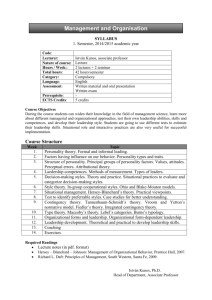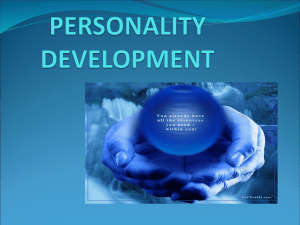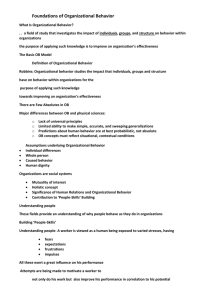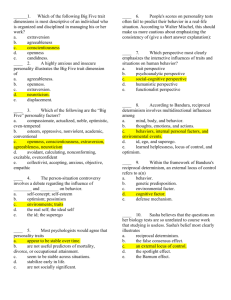PPt.
advertisement
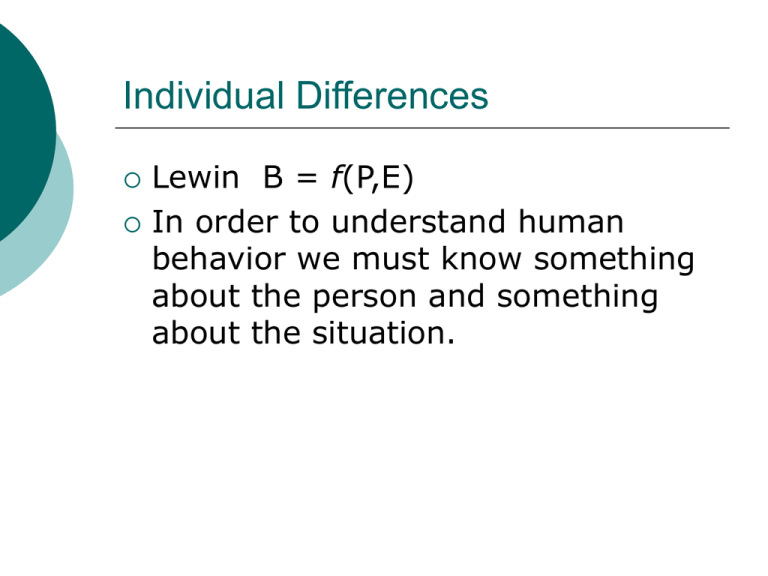
Individual Differences Lewin B = f(P,E) In order to understand human behavior we must know something about the person and something about the situation. The Person Skills and Abilities Personality Perceptions Attributions Attitudes Values The Situation or Environment Organization (structure & design) Work Group (size, norms, cohesive) Job (complexity, variety, feedback) Personal Life (work/family conflict) Other Situational Factors Personality Defined Relatively stable pattern of behaviors and consistent internal states that explain a person's behavioral tendencies Personality is shaped by both heredity and environment Biological Basis - Heredity Traits associated with temperament and sociability traced to genetics Preferences in clothing, food, habits, appearance Tendencies toward extroversion leadership, dominance resistance to stress, work ethic, achievement Environmental or Situational Basis Examples of situational influences include family, cultural, educational influences, the way we are rewarded and punished etc. Traits like aggression, risk aversion, need for intimacy and comfort Measuring Personality Projective tests – pictures, abstract images, photos, Ink blot Behavioral measures – observing behavior in a controlled situation where you can record occurrences Self-report questionnaire (MMPI) (NEO) (MBTI) General Conclusions: Behavior is a function of the person interacting with his/her environment. Both play almost equal parts. Personality traits are less evident in situations where social norms, rules, reward systems, or consequences constrain behavior General Conclusions Con’t Personality tests were widely used in selection 40 years ago Research began to report a weak relationship between those tests and actual job performance Tests might unfairly discriminate against some groups of people General Conclusions Con’t In the last 10 years some personality traits have regained some credibility in predicted workrelated behaviors, stress reactions, and emotions In general, personality tests are not good predictors of job performance Personality Variables in OB Research Big Five MBTI Locus of Control Self-Monitoring Self-Esteem Self-Efficacy Negative/Positive Affect Big Five Personality Dimensions Conscientiousness (h,l) – careful, dependable, self-disciplined Agreeableness(h,l) – courteous, goodnatured, empathic, caring Emotional Stability/Neuroticism – poised, secure, calm; anxious, hostile, depressed Openness to experience(h,l) (most complex) - Sensitive, flexible, creative, curious, less resistant to change Extroversion/Introversion – outgoing, talkative, sociable, assertive; quiet, cautious, often shy MBTI – Myers-Briggs Type Indicator Extroversion: Energy directed outward toward people and things. Focus – change the world. Seeks variety and action. Introversion: Energy directed inward toward concepts and ideas. Focus – understand the world. Seeks quiet for concentration. Sensing/Intuition Sensing – mode of perception is the five senses, reliance on experience and data. Focus is practical and reality. Prefers using learned skills, pays attention to details and facts. Intuition – mode of perception is intuition, what is possible. Focus is on the future, innovation. Prefers adding new skills, looking at complex patterns. Thinking/Feeling Thinking – Mode of decision making is based on logic. Focus is on things, truth, principles solving problems. Treats others fairly, less personable, more businesslike. Feeling – Mode of decision making is on human values and needs. Focus is on people, harmony, being supportive. Acts more personable, friendly. Judgment/Perception Judgment – lifestyle involves planning. Focus is being decisive, purposeful. Closure is important, completing tasks, making decisions. Perception – lifestyle is more spontaneous. Focus is curious, flexible, and adaptable. Considering possibilities, gathering information, postpone decisions. Locus of Control and Self-Monitoring Locus of control Internals believe in their effort and ability Externals believe events are mainly due to external causes Self-monitoring (high, low) Extent to which people base their behavior on cues from other people and situations Self Monitoring Self Monitoring – Situational appropriateness, Self expression and Self presentation. High SM’s use situational cues or social information to regulate their own verbal and nonverbal self presentation. Low SM act more from internal, dispositional states. Their behavior is more consistent. Self Esteem and Self Efficacy Self Esteem – a belief about one’s own worth based on an overall evaluation Self Efficacy – a person’s belief about her chances of successfully accomplishing a specific task Negative/Positive Affect Negative Affect – a temporary mood state or a more chronic tendency toward negative emotionality and self concept. Positive Affect – a mood/disposition to focus on the positive aspects of themselves, others and the world in general
